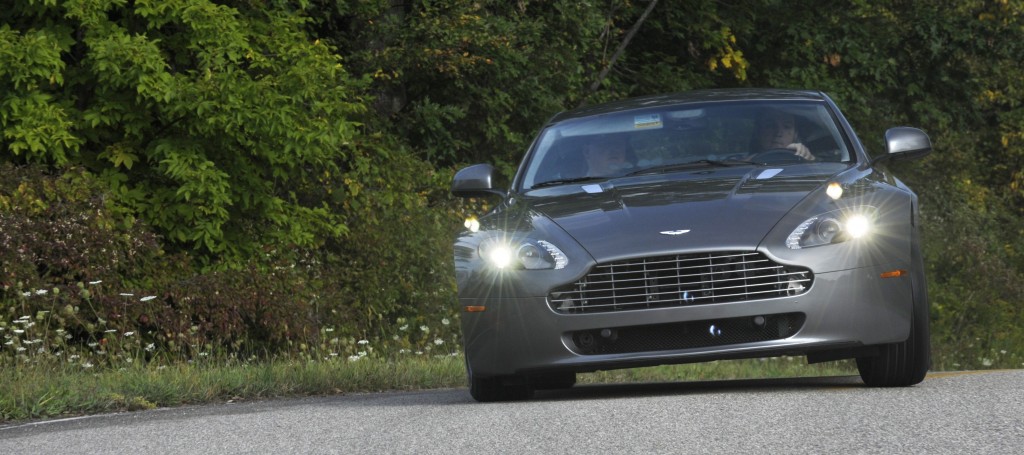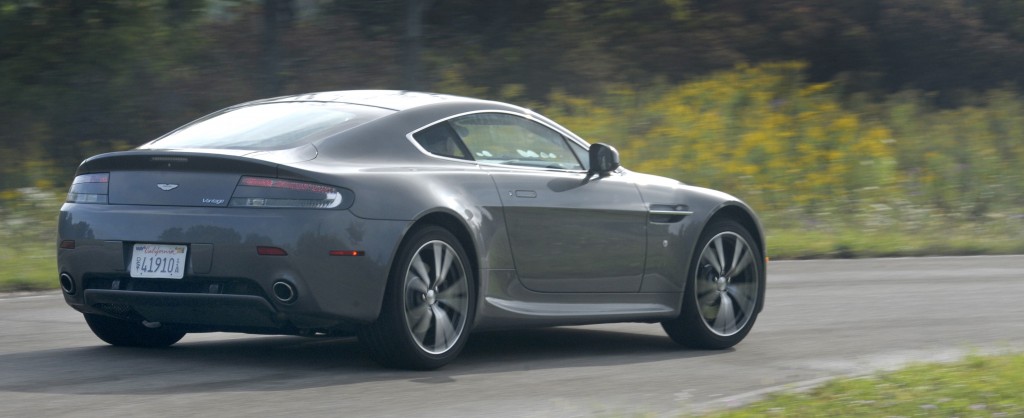First Drive: 2010 Aston Martin Vantage Coupe
[svgallery name=”10_Aston_Martin_Vantage”]
Story by John LeBlanc. Photos by Aaron Kiley.
The leather-wrapped steering wheel I’m clutching is attached to a brand-new Vantage Coupé. Yet staring at that chrome-winged logo spelling out “Aston Martin,” nostalgia washes over me.
My first Aston memories are of this car’s legendary predecessor – the first V8 Vantage built 32 years ago. Unlike today’s so-called “entry level” Vantage – the two-seat $135,495 Coupé – the original Vantage was a real British bulldog: the carmaker’s top 2+2 grand touring machine that was the equivalent of today’s $300,000-plus DBS.
At various times since then, Aston Martin has dusted off the Vantage badge, mainly to designate its flagship model.
Between 1992 and 1995, a 550-horsepower twin-supercharged version of the venerable V8 from the Virage bore the Vantage name, as did the 1999 DB7 Vantage, powered by Aston Martin’s first ever V12.
So when today’s Vantage was first shown as a concept at the 2003 Detroit auto show, the name conjured up all kinds of warm, British grand touring car feelings.
Except that concept wasn’t what I recognized as a “Vantage” at all: this car was a two-seater, not a 2+2 GT as its namesakes had been. It was also priced at the lower end of the Aston Martin lineup – contrary to every other previous Vantage.
Unlike the ’77 Vantage, which with its aftermarket-like rally fog lights and bulging engine hood blister looked like a bit of a roughneck, that reworked Vantage looked like podium material for Canada’s Next Top Model.
Blasphemy! Heresy! The retooled Vantage just wasn’t cricket.
But then, I hadn’t driven the car. When I did for the first time two years ago, its agile handling and immediate responses made it my favourite car in the British firm’s lineup from a pure driving perspective.
Good as it was, though, it still wasn’t sharp enough to make me forget about wanting a $109,900 Porsche 911 Carrera S. The Vantage’s extra weight always made itself known, whether you were accelerating, turning or braking.
But now after driving the 2010 Vantage, with its raft of recent power and suspension upgrades, the entry-level Aston Martin pushes all the right sports car buttons, from both a subjective and objective point of view.
Using a higher-performing version of the brand’s first V8 (introduced on the 1969 DBS), the original V8 Vantage’s 5.3-litre mill was rated at 380 hp. This gave it a top speed of 274 km/h and a 0-to-100 km/h time of 5.5 seconds.
Piffling perhaps by today’s standards. Serious stuff, though, on the verge of the first oil crisis when fast and fun cars dropped like undergarments at a Tom Jones concert.
The 2010 Vantage’s smaller 4.7-litre V8 is much more efficient. After upgrades last year, it’s now rated at 420 hp (an 11 per cent increase on the previous 4.3-litre unit) and 346 lb.-ft. of torque (a 15 per cent increase).
In addition to the more obvious punch in the back, 0-to-100 km/h using the accurate-shifting six-speed manual (a Touchtronic six-speed auto box is available for $5,000) takes 4.5 seconds – 0.8 seconds faster than before, as quick as big brother DBS and 0.2 seconds faster than a 911 S.
I’ve never had the opportunity to find out what that original mid-’70s Vantage drove like. (I’m guessing somewhere between an ox cart and a contemporary Firebird Trans-Am.) But it’s safe to say that its modern namesake would leave it for dust on a back road.
With revised shock mounts and bump stops, and stiffer springs all around, the 2010 Vantage feels much more tied down to the road than the previous model.
But then my 2010 Vantage also came with the $4,920 Sports Pack, available for both Coupé and Roadster. Lighter alloy wheels, retuned Bilstein shocks, upgraded springs and a revised rear anti-roll bar delivered even greater agility, high-speed body control and precision when at speed.
When driven like you’re late for the lord of the manor’s annual garden party, the Vantage’s turn-in and body control are potato-chip crisp. The car always feels buttoned down and predictable.
Unlike some of its rear-engined (Porsche 911) and mid-engined (Audi R8) rivals, the Vantage is very forgiving in aggressive manoeuvres. Its stability control allows some tolerance, but is gradual when called upon, while its steering is well-weighted and accurate.
It’s been said that you can never go home. And in the case of the first and the last of Aston Martin Vantages, I’m not sure I’d want to travel back in time. No doubt any warm fuzzy feelings I still have for the original would be wiped out by the cold realities of more than two decades of progress.
But what the latest Vantage has in common with the 1977 original is gobs of personality, a quality sometimes lacking in cars costing well into the six figures.







![[del.icio.us]](https://www.straight-six.com/wp-content/plugins/bookmarkify/delicious.png)
![[Digg]](https://www.straight-six.com/wp-content/plugins/bookmarkify/digg.png)
![[Facebook]](https://www.straight-six.com/wp-content/plugins/bookmarkify/facebook.png)
![[Google]](https://www.straight-six.com/wp-content/plugins/bookmarkify/google.png)
![[Reddit]](https://www.straight-six.com/wp-content/plugins/bookmarkify/reddit.png)
![[StumbleUpon]](https://www.straight-six.com/wp-content/plugins/bookmarkify/stumbleupon.png)
![[Twitter]](https://www.straight-six.com/wp-content/plugins/bookmarkify/twitter.png)
![[Email]](https://www.straight-six.com/wp-content/plugins/bookmarkify/email.png)